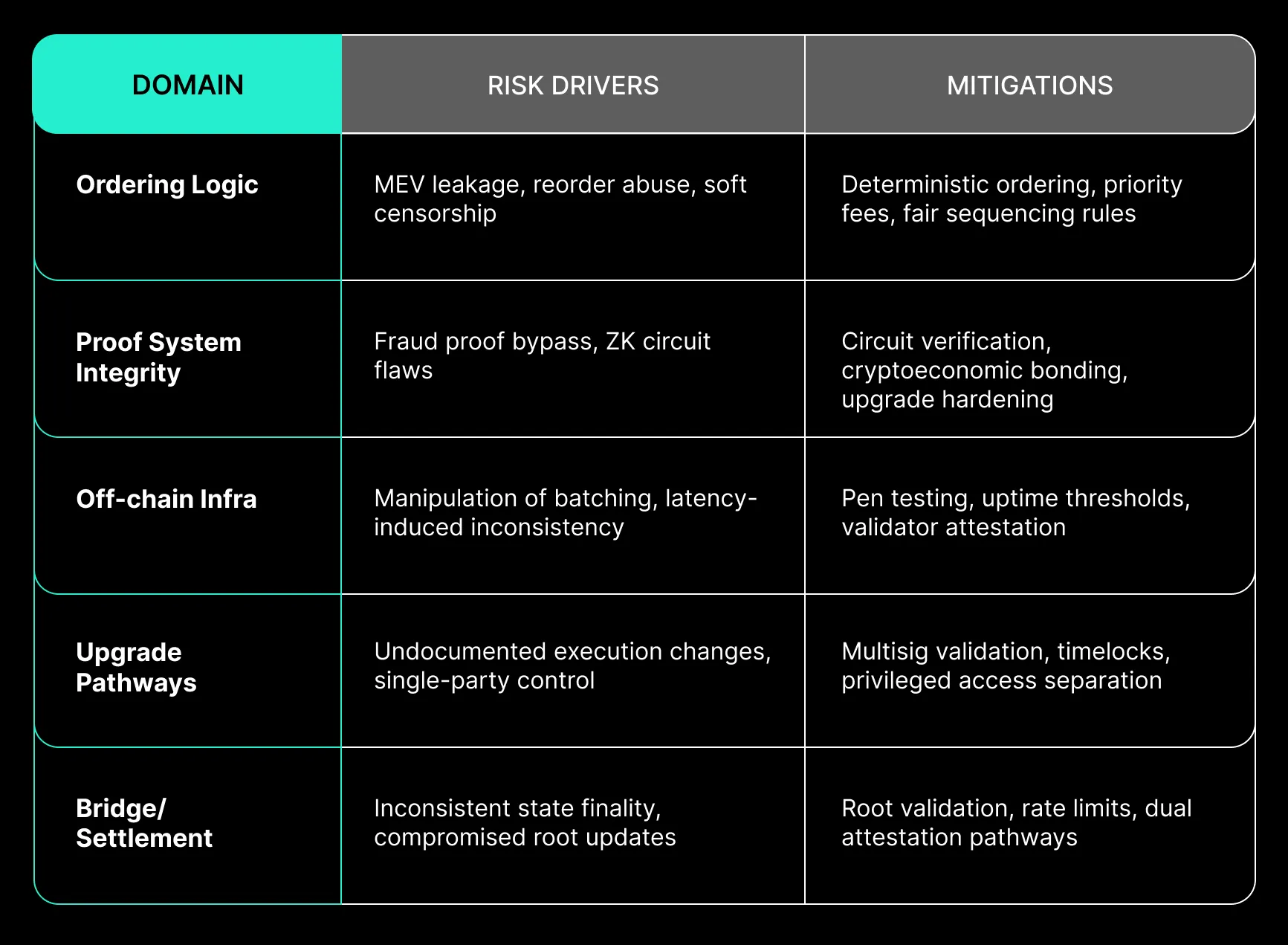Introduction
As Ethereum scales through rollup-centric infrastructure, sequencing has emerged as a critical function for Layer 2 protocols. Sequencing defines how transactions are ordered, executed, and finalized before settlement on Ethereum mainnet. With billions in value secured across rollups, the design, integrity, and decentralization of sequencers directly affect censorship resistance, MEV exposure, and trust guarantees.
Protocols are moving toward Ethereum-aligned sequencing systems. Base Rollups utilize Ethereum validators as sequencers. Native Rollups integrate with the L1 execution layer via precompiled contracts. Both designs present unique security requirements that span smart contracts, off-chain orchestration, bridge logic, and consensus coordination.
Spearbit applies full-lifecycle validation across these systems, addressing the execution, ordering, and trust assumptions embedded in sequencing pipelines. This framework outlines key domains, risk models, and structured engagements that support secure and verifiable sequencing architectures.
Ethereum Sequencing Models: Base vs Native

Base Rollups enhance decentralization by aligning with Ethereum’s validator set. Native Rollups integrate directly with Ethereum’s execution logic, increasing auditability and security guarantees. Each model demands distinct validation of ordering logic, proof pipelines, and upgrade control.
Decomposing the Sequencing Stack
Sequencing systems introduce layered technical complexity. Security reviews must address:
- Transaction ordering and batching mechanisms
- Proof construction and validity publishing
- State root generation and settlement contracts
- Interactions with DA layers and fraud/ZK verification models
- Governance and upgrade permissions for sequencing logic
Without clear boundaries and validated transitions, each layer becomes an independent failure point.
Key Security Domains in Sequencer Architecture

Lifecycle-Aligned Engagements
Spearbit’s structured reviews cover the complete lifecycle of sequencing systems. Each phase introduces unique threats that require tailored scopes:
Design Phase
- Threat modeling of ordering guarantees and latency assumptions
- Economic modeling for MEV incentives and L1 alignment
- Sequencer fallback and failure mode simulation
Implementation Phase
- Rollup contract inspection for ordering, batching, and submission logic
- Proof validation system design review (fraud/ZK proof triggers, circuit integrity)
- Infrastructure reviews for sequencer API, DA integration, and batch coordination
Pre-Deployment Phase
- Governance path review for sequencer selection, revocation, and rotation
- Deployment sequencing and contingency validation
- Interface review for proof submission and fallback behavior
Post-Launch Phase
- Monitoring integration for sequencing slippage and anomaly detection
- Bug bounty infrastructure scoped to off-chain ordering behavior and circuit edge cases
- Governance change enforcement, audit re-validation, and proof upgrade flow modeling
Use Case: Rollup Batching and Circuit Failure Detection
In rollup systems that submit ZK proofs to Ethereum, edge cases can emerge when transitioning from inactive to active batch queues under variable latency conditions. One observed pattern involved stale circuits accepting valid input and producing misaligned root states. These outputs passed contract-level validation but diverged from intended system logic.
This issue exposed a delay window where invalid state could be introduced before challenge windows expired. Resolution required updates across the batching pipeline, including enforced root consistency checks and external monitoring of circuit behavior beyond standard on-chain verification.
Forward-Looking Consideration: Shared Sequencers
Emerging shared sequencing networks introduce complex interdependencies between rollups, validators, and ordering services. Spearbit applies adversarial modeling and stakeholder analysis across these coordination layers to evaluate failure domains and security guarantees under variable liveness and fault assumptions.
Sequencer Security as a Continuous Function
Sequencing security cannot be validated in isolation. Ordering, execution, and state transitions span systems across L1, L2, off-chain components, and DA providers. Effective protection requires alignment of incentives, visibility across coordination layers, and layered validation.
Spearbit’s model enables organizations to begin with scoped sequencing reviews and evolve into full-lifecycle programs. Continuity of context between rollup logic, proof systems, and coordination infrastructure creates a foundation for resilient execution environments.
From an evaluation lens, sequencing design often signals protocol maturity. Transparent governance, decentralized ordering, and circuit integrity contribute to higher Web3SOC maturity scores and institutional confidence.
Conclusion
Rollup-centric scaling has introduced new dimensions of trust and complexity into Ethereum’s ecosystem. Sequencers are pivotal components, shaping how transaction order, fairness, and execution are preserved. As the industry progresses toward decentralized and Ethereum-native sequencing, protocols must account for layered risk across infrastructure, economics, and logic.
Contact us to plan your security engagement and protect your rollup architecture end to end.




